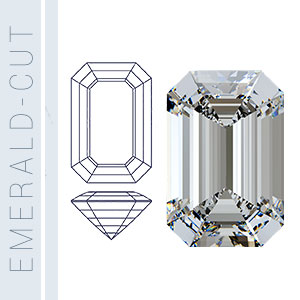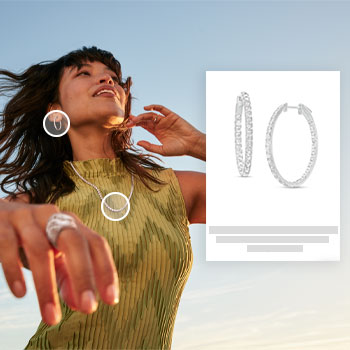Emerald-Cut Diamonds
There are certain diamond cuts that beautifully exemplify classic sophistication. The emerald-cut diamond offers historical charm paired with modern glamour — and boasts a uniqueness all its own. Learn more about this elegant diamond-cut and see if the emerald-cut diamond is right for you.

What is an Emerald-Cut Diamond?
The emerald-cut is a bold and dramatic shape with enviable Old World charm. At its most basic, the emerald-cut is rectangular in shape with cut corners. This diamond shape also features a characteristic wide, flat plane with edges that look like stairs when viewed from the top. As a result, the emerald-cut is often referred to as a "step-cut".
Emerald-cut diamonds are comprised of either 57 or 58 facets. The number of facet rows on the crown or pavilion of the emerald-cut varies in number, altering the total facet number.
As with all diamond shapes, the emerald cut presents a trade-off: its rectangular shape does not sparkle as brightly as other shapes but does create the exquisite “Hall of Mirrors” effect with long, dramatic lines and an unmatched allure.
Emerald-cut diamonds prove quite rare and are more difficult to find. Emerald-cut diamonds represent only three percent (3%) of the world’s diamonds. What’s more, their rarity also means that emerald diamonds tend to cost more than other diamond shapes. However, to help balance out the higher price, the emerald-cut shape creates the illusion of being larger than other diamond shapes per carat.
Despite their rarity, emerald-cut diamonds have gained popularity in recent years as A-list celebrities, like Angelina Jolie, Amal Clooney and Beyoncé began favoring this extraordinary shape.
History of the Emerald-Cut Diamond
The emerald-cut shape dates back to the 1500’s and was one of the first cuts used in fine jewellery pieces. Originally, stonecutters used the shape for cutting true emeralds, giving this style of cut its name. Stone cutters of that era found that true emeralds were soft and prone to breaking, but the stepped facets of the emerald-cut helped to give them increased stability.
Though the exact origin of the emerald-cut remains uncertain, the term “emerald-cut” first became popular during the Art Deco period of the 1920s. The shape’s unclear origins are partially due to the fact that the emerald-cut was seen more as a tool known by a variety of names in the context of cutting emerald gems. Art Deco diamond cutters soon realized that the shape also lent itself well to diamonds, creating the newly popular emerald and baguette-cut shapes.
Grading System of Peoples Emerald-Cut Diamonds
At Peoples, we rely on trusted experts from different gemological laboratories to grade our precious stones.
To determine a diamond’s grade, these labs inspect each diamond under closely controlled lighting and viewing conditions. Trained grading professionals use highly calibrated measurement devices to capture important data for use in determining the emerald-cut diamond’s quality. These experts will then grade our emerald-cut-cut diamonds on the following determinations:
Emerald-Cut Carat
Every diamond is measured using the carat weight system. Experts uses
specially calibrated scales to ensure an accurate measurement with weights
measured to the hundred-thousandths of a carat. In the carat system, one
metric carat is equal to 0.2 gram.
Similar to the oval shape, emerald-cuts tend to have a larger physical appearance for their carat weight when compared to other diamond shapes. If you and your partner prefer a stone with a larger appearance and a distinctive look, the emerald-cut diamond might be your ideal shape.
Emerald-Cut Colour
The industry standard diamond colour grading system ranges from D grades
(colourless), continuing alphabetically with increasing levels of colour to Z
grades.
Industry experts use master stones in order to grade diamond colour. Our diamond experts hold each diamond to rigorous test standards, using master stone sets that pass these tests prior to use.
With emerald-cut diamonds, you can often more easily see diamond body colour due to large, open facets in the diamond shape. With that in mind, we strongly recommend that you pay special attention to the colour of the diamond when shopping for emerald-cuts.
Additionally, the setting colour and material selected for your emerald-cut diamond can make an immense difference in the diamond’s colour. Ideally, a diamond should look colourless against its setting. For instance, a diamond with a yellow tint will shine best in a yellow-gold setting. For this reason, we strongly recommend keeping your setting options in mind when shopping for your emerald-cut diamond and evaluating its colour.
Emerald-Cut Clarity
Diamond clarity refers to the appearance of the stone – including any
blemishes or inclusions. Our diamond experts grade diamond clarity as one of
six grades: Flawless, Internally Flawless, Very Very Small Inclusions, Very
Small Inclusions, Small Inclusions, or Imperfect.
Evaluating an emerald-cut diamond clarity is subjective (just like evaluating colour). Because of the nature of the wide, flat table of an emerald-diamond, clarity tends to be especially important with this diamond shape. Often, inclusions are easier to see with emerald-cut diamonds. As such, we recommend selecting a higher clarity when shopping for this diamond shape.
What You Should Look for in an Emerald-Cut Diamond
Because they are so different from other diamond cuts, there are important things your should consider prior to making your purchase.
A Good Clarity Grade
Emerald-cut diamonds feature large, open facets and a wide table. This wide
palette makes inclusions and clarity issues more visible versus other diamond
shapes. For this reason, we recommend selecting an emerald-cut diamond with a
higher clarity grade to ensure that your stone looks completely clean to the
naked human eye.
Emerald-Cut Length-to-Width
Ratio
The majority of emerald-cut diamonds will have a length-to-width ratio
between 1.30 to 1.50. If you prefer a more square shape, select a diamond
with a lower ratio. If you want something more rectangular, choose a diamond
with a higher ratio. We recommend viewing a variety of emerald-cut diamonds
to determine your preferred ratio.
What is the Best Setting for an Emerald-Cut Diamond
Among diamond shapes, emerald-cut diamonds are highly versatile and compment a variety of jewellery settings.
Two of the most popular settings for emerald-cut diamonds are:
Solitaire Settings: offer an elegant simplicity that helps your emerald-cut diamond stand out even more. Be sure to choose a setting with prongs that wrap the stone’s sharp corners, as the emerald-cut diamond can chip or even break.
Halo Settings: help create a beautiful sparkle that enhances the vintage feel of your emerald-cut diamond. A border of smaller diamonds surrounding the centre stone make it appear larger with more scintillation.
No matter what setting you prefer, an emerald-cut diamond always looks distinctively stunning. Its versatility also makes it the ideal cut for custom jewellery pieces.
Emerald-Cut Diamonds: Conclusion
For centuries, diamond cutters and wearers alike have celebrated the rectangular “stepped” shape of the emerald-cut diamond for its mesmerizing “hall of mirrors” effect and larger appearance. Only accounting for three percent of diamonds worldwide, the emerald-cut is a rare shape popular in one-of-a-kind fine jewellery pieces.
The wide, flat plane of the emerald-cut’ diamond’s shape highlights the clarity and natural beauty of a rectangular diamond. With unmatched versatility, the emerald-cut suits an array of settings, making it a highly customizable and as unique as your taste.
For a unique diamond shape that showcases the Old-World charm of the Art Deco period, explore the Peoples selection of exquisite emerald-cut diamond engagement rings.





 They will be on video but won't see you.
They will be on video but won't see you. Make sure to enable your mic if prompted.
Make sure to enable your mic if prompted. Language:
Language:
